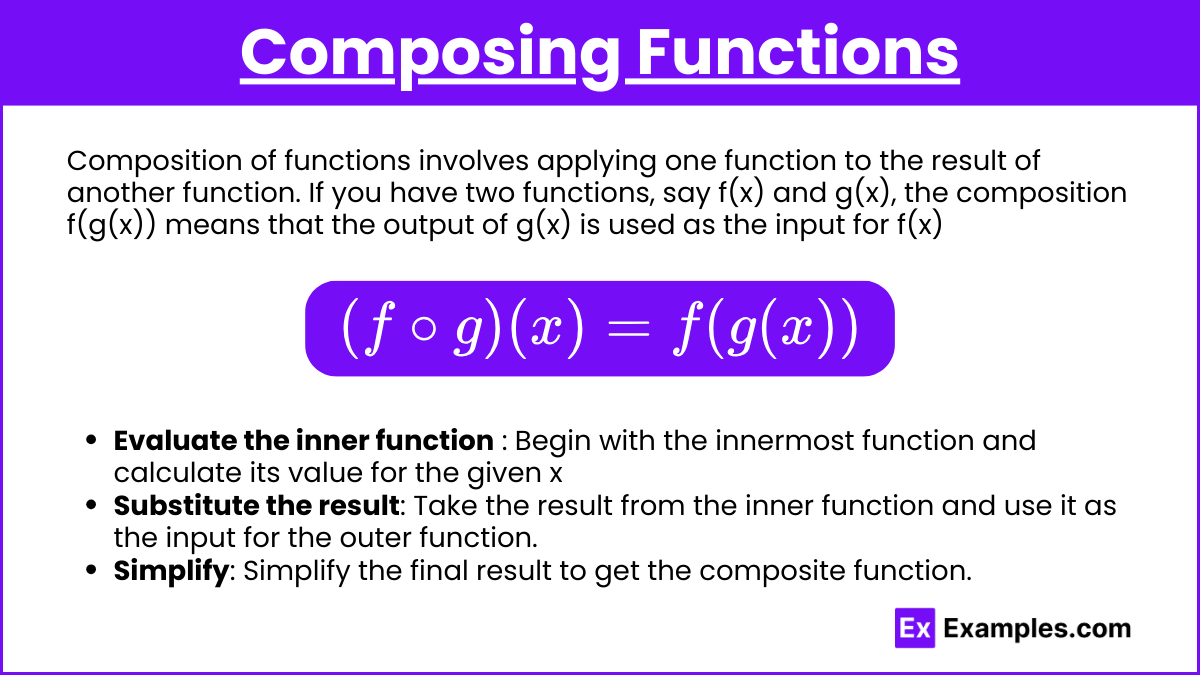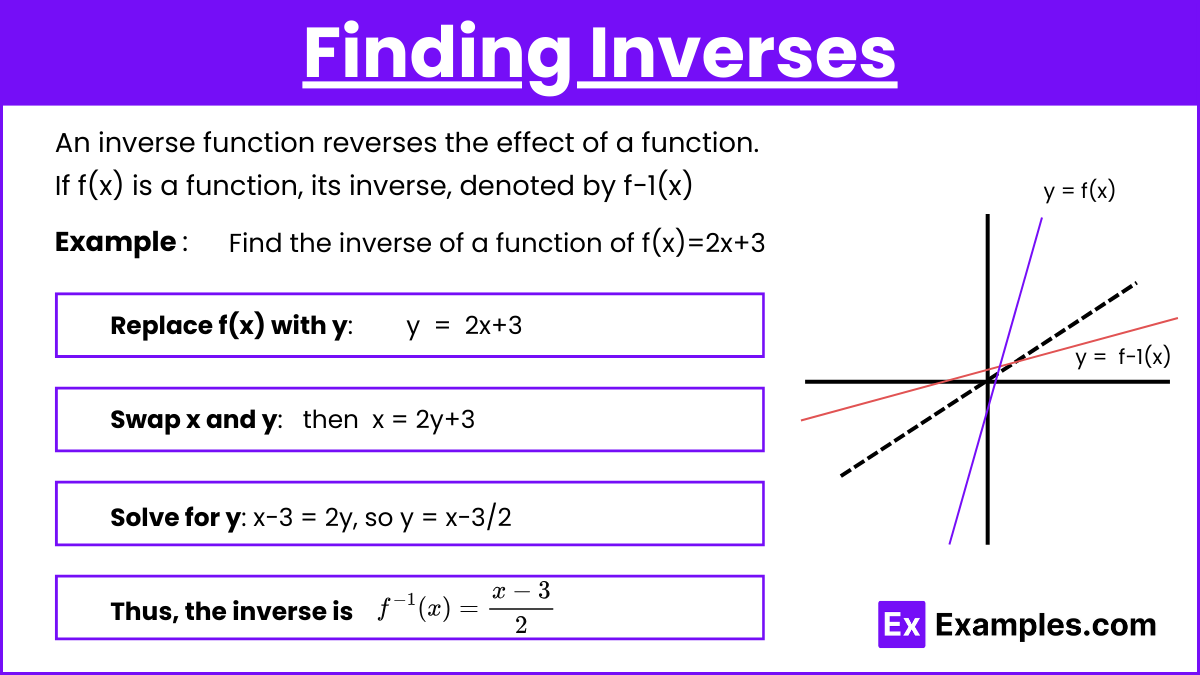In AP Precalculus, composing functions and finding inverses are fundamental concepts that involve manipulating and understanding relationships between functions. Composition combines two functions, where the output of one function becomes the input of another. This technique helps analyze more complex mathematical models. Inverses, on the other hand, reverse the effects of a function, allowing us to retrieve original input values from the output. Mastering these skills is crucial for solving advanced problems, including function transformations and real-world applications in calculus and algebra.
Free AP Precalculus Practice Test
Learning Objectives
In studying "Composing Functions and Finding Inverses" for AP Precalculus, you should learn how to combine two functions to create a new function through composition, understanding the process of evaluating composite functions. You should also master the concept of inverse functions, learning how to find the inverse of a function by switching variables and solving for the inverse. Additionally, you need to identify when a function has an inverse by recognizing one-to-one functions and practice verifying inverses using composition to confirm they undo each other.
Composing Functions

Composition of functions involves applying one function to the result of another function. If you have two functions, say f(x) and g(x), the composition f(g(x)) means that the output of g(x) is used as the input for f(x). Function composition is represented as:
Steps to compose functions
Evaluate the inner function: Begin with the innermost function and calculate its value for the given x.
Start by identifying the inner function, g(x), and compute its value for a given input x. The inner function is the one that appears inside another function when looking at a composition. This evaluation may involve applying arithmetic operations, applying formulas, or simplifying expressions based on the input values. The result of the inner function evaluation will be used in the next step.
Substitute the result: Take the result from the inner function and use it as the input for the outer function.
Once you have evaluated the inner function, substitute its result into the outer function f(x). This means replacing the variable x in the outer function with the value or expression obtained from the inner function. In this step, you're essentially treating the output of g(x) as the new input for f(x).
Simplify: Simplify the final result to get the composite function. After substituting the result from the inner function into the outer function, simplify the resulting expression if necessary. This may involve combining like terms, performing arithmetic operations, or simplifying any complex expressions. Simplification is crucial to ensure the final expression is as concise as possible.
For example, if:
f(x) = 2x+3
g(x) = x2−1
Then, f ( g (x) ) would be:
Finding Inverses

An inverse function reverses the effect of a function. If f(x) is a function, its inverse, denoted by f−1(x), satisfies:
Steps to find the inverse of a function
Write the function in terms of y: The first step in finding the inverse is to rewrite the given function f(x) by replacing f(x) with y. This means expressing the function equation in a way that it clearly represents a relationship between x and y. Writing it in terms of y helps to clarify that y is dependent on x, and we will eventually solve for x in terms of y.
Swap x and y: To find the inverse, you swap the roles of x and y. This reflects the idea that the inverse function reverses the roles of inputs and outputs. Geometrically, this step corresponds to reflecting the function across the line y = x, which means interchanging x and y. The function will now represent the relationship from y back to x.
Solve for y: The final step is to solve the resulting equation for yyy, which will now represent the inverse function f−1(x). Solving for y typically involves performing algebraic operations to isolate y on one side of the equation. The expression you obtain for y is the formula for the inverse function.
For example, if:
f(x)=2x+3
Replace f(x) with y: y = 2x+3
Swap x and y: x = 2y+3
Solve for y: x−3 = 2y, so y = x−3/2
Thus, the inverse is:
Verifying Inverses:
To verify that two functions are inverses, check that:
For the functions f(x) = 2x+3 and
Examples
Example 1
Let f(x) = x+5 and g(x) = 3x.
Composition: f(g(x)) = f(3x) = 3x+5.
Inverse of f(x): To find the inverse of f(x) = x+5, replace f(x) with y, so y = x+5. Swapping x and y, x = y+5. Solving for y, y = x−5, so f−1(x) = x−5.
Example 2
Given f(x) = 2x+1 and g(x) = x2,
Composition: f(g(x)) = f(x2)=2x2+1.
Inverse of f(x): Start with y = 2x+1, swap to x = 2y+1, then solve for y: , so the inverse is .
Example 3
For and g(x) = x+3,
Composition: .
Inverse of f(x): Since , start with , swap to , then , which means the inverse is .
Example 4
Let f(x) = x2 and g(x) = x−2,
Composition: .
Inverse of f(x) (restricted to positive values): y = x2, swap to x = y2, solve for y: , so .
Example 5
Consider f(x)=3x−4 and ,
Composition:
Inverse of f(x): Begin with y=3x−4, swap to x=3y−4, then solve for y: , so .
Multiple Choice Questions
Question 1
A population of bacteria doubles every 3 hours. If the initial population is 100 bacteria, which of the following exponential functions represents the population P(t) after t hours?
A) P(t)=100×2t
B) P(t)=100×2t/3
C) P(t)=100×23t
D) P(t)=100×3t/2
Answer: B) P(t) = 100 × 2t/3
Explanation: In this scenario, the population doubles every 3 hours. The general form of an exponential growth model is P(t) = P0 × 2t/T, where P0 is the initial population, T is the doubling time, and t is time. Here, P0 = 100, and the doubling time T = 3 hours, so the correct function is P(t) = 100×2t/3.
Question 2
Which of the following data sets is best modeled by an exponential function?
A) A car's speed increasing at a constant rate.
B) The value of a stock increasing by 10% each year.
C) The distance covered by an object moving at a constant speed.
D) The temperature of a hot cup of coffee cooling in a room.
Answer: B) The value of a stock increasing by 10% each year.
Explanation: An exponential function is appropriate when a quantity grows or decays by a constant percentage or factor over equal intervals of time. In option B, the stock's value increases by 10% every year, which represents a growth factor of 1.10 per year, making it best modeled by an exponential function. In contrast, A and C describe linear relationships, and D describes exponential decay, which could also be exponential but is not focused on growth as this question is.
Question 3
Given the exponential model N(t)=50×1.05t, where N(t) represents the number of visitors to a website over time t in days, what will the number of visitors be after 10 days?
A) 62
B) 81
C) 82
D) 91
Answer: C) 82
Explanation: To find the number of visitors after 10 days, substitute t = 10 into the exponential model: N(10) = 50×1.0510
First, calculate 1.0510, which is approximately 1.629. Then multiply by the initial value: N(10) ≈ 50×1.629 = 81.45
Rounding this value gives approximately 82 visitors after 10 days. Therefore, the correct answer is C) 82.


